Navigation
Install the app
How to install the app on iOS
Follow along with the video below to see how to install our site as a web app on your home screen.
Note: This feature may not be available in some browsers.
More options
Style variation
-
Congratulations TugboatEng on being selected by the Eng-Tips community for having the most helpful posts in the forums last week. Way to Go!
You are using an out of date browser. It may not display this or other websites correctly.
You should upgrade or use an alternative browser.
You should upgrade or use an alternative browser.
Baltimore Bridge collapse after ship collision 125
- Thread starter Tomfh
- Start date
- Status
- Not open for further replies.
Murph 9000
Computer
enginesrus said:The excessive smoke from the engines looks like they were throttled up, then backed off. What engine or engines does this ship have? How many props?
It's a single MAN B&W 9S90ME-C9 (56396 hp, 2 stroke diesel, 9 cylinder, 3260mm stroke, 900mm bore) with a fixed pitch propeller. 4 or 5 stories in height.
TugboatEng
Marine/Ocean
One thing to note is that a ship's propeller only generates about 50% of its rated load when operating astern. It should not load the engine to cause it to smoke like that.
Retiredat46
Member
This article in the Daily Mail and a similar one in Daily beast caught my eye, but I'm not sure how reliable these reports might be.
Dali cargo ship suffered 'severe electrical problem' while docked in Baltimore days prior to bridge collapse crash that saw it suffer 'total power failure, loss of engine failure', port worker says
Dali cargo ship suffered 'severe electrical problem' while docked in Baltimore days prior to bridge collapse crash that saw it suffer 'total power failure, loss of engine failure', port worker says
- Thread starter
- #104
LittleInch
Petroleum
The insurance claims might be big money, but like we saw in the Suez grounding, shipping have their own rules dating back centuries to limit the claim on the owners to the vessel and cargo value.
The insurers will very soon declare "general average" I think to share the costs.
Remember - More details = better answers
Also: If you get a response it's polite to respond to it.
The insurers will very soon declare "general average" I think to share the costs.
Remember - More details = better answers
Also: If you get a response it's polite to respond to it.
Tomfh,
The dolphins are supposed to make the ship absorb its own impact, rather than transferring it to the bridge supports. These articles show some of the dolphins at the Sunshine Skyway Bridge which were installed after the old bridge was brought down.
The dolphins are supposed to make the ship absorb its own impact, rather than transferring it to the bridge supports. These articles show some of the dolphins at the Sunshine Skyway Bridge which were installed after the old bridge was brought down.
Murph 9000
Computer
Tomfh said:How do the dolphins work? Where does all that energy go?
Some will be lost to ablation of the dolphin. Some will be used deflecting the ship to the side (it's unlikely to be a perfectly aligned hit, so it's going to be to one side of the ship's centerline). The rest goes to tearing away shell plating and turning heavy steel into mangled scrap.
That's assuming the dolphin is securely attached to the planet. Build quality may vary.
- Moderator
- #109
I have seen dolphins bend and rebound when impacted by a large ferry.
I used to ride a ferry every week.
As memory serves the capacity would have been about 80 cars and 600 passengers.
At one side of the approach to the dock were a line of dolphins, at the other side one or two dolphins.
At times a "Cowboy Captain" would come into the wharf too fast and scrub off speed by hitting a dolphin a glancing blow.
The dolphin would deflect and rebound.
The rebound would push the ferry across to the other side were it would sideswipe one or two more dolphins.
That, combined with bow thrusters and/or reverse thrust would slow the ferry almost to a stop.
Most of the energy and speed lost would be scrubbed off by the redirection of the mass of the vessel to an altered line of travel.
These dolphins were not solid concrete but the old school, driven pile dolphins.
That is, a large number of driven pilings were bound together by cables.
--------------------
Ohm's law
Not just a good idea;
It's the LAW!
I used to ride a ferry every week.
As memory serves the capacity would have been about 80 cars and 600 passengers.
At one side of the approach to the dock were a line of dolphins, at the other side one or two dolphins.
At times a "Cowboy Captain" would come into the wharf too fast and scrub off speed by hitting a dolphin a glancing blow.
The dolphin would deflect and rebound.
The rebound would push the ferry across to the other side were it would sideswipe one or two more dolphins.
That, combined with bow thrusters and/or reverse thrust would slow the ferry almost to a stop.
Most of the energy and speed lost would be scrubbed off by the redirection of the mass of the vessel to an altered line of travel.
These dolphins were not solid concrete but the old school, driven pile dolphins.
That is, a large number of driven pilings were bound together by cables.
--------------------
Ohm's law
Not just a good idea;
It's the LAW!
TugboatEng
Marine/Ocean
I strongly disagree with this. A glancing blow is one thing but if energy is being dissipated metal is getting bent. We use tires and rubber fenders to absorb energy on the tugs but any time the tugs make contact where the tires don't protect there is usually significant structural damage.
- Moderator
- #111
TugboatEng
Marine/Ocean
Any force > 0. The question is how quickly you want to change the vector of travel.
In your case the ferry may have touched the whalers but the engine was doing the braking.
Here is a recent example of the results of a ferry using whalers as brakes.
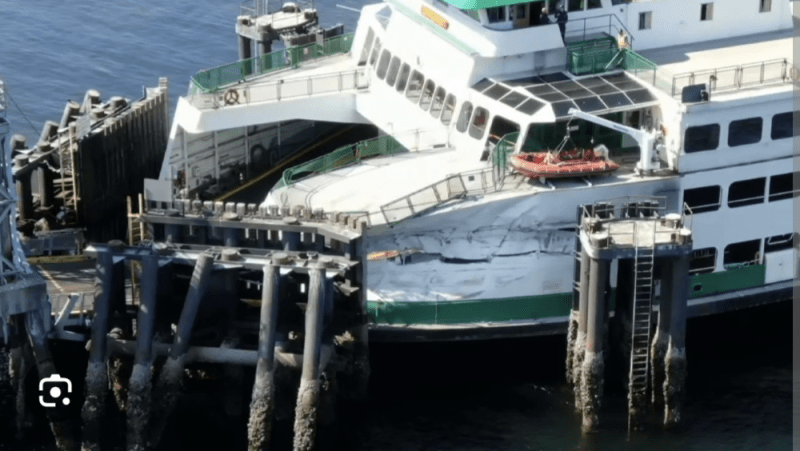
In your case the ferry may have touched the whalers but the engine was doing the braking.
Here is a recent example of the results of a ferry using whalers as brakes.

- Moderator
- #113
I was there Tug.
I saw the dolphins bend/deflect several feet as the ferry hit a glancing blow.
The dolphin then rebounded and the ferry hit the dolphin on the other side a glancing blow.
A small part of the energy may have been dissipated by the shock absorbers of 80 cars rocking from side to side.
Not a lot of energy, but a strong indication that the vessel had been redirected.
A normal landing would rely on the bow thruster and reverse thrust.
When the ferry was obviously coming in faster than usual, we would do the dolphin bounce.
A lot of the old dolphins have been replaced by these rebound structures.
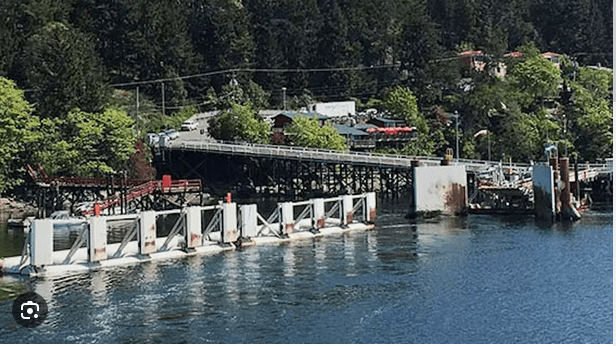
These are not intended to take a direct hit but work very well when struck a glancing blow by a ferry.
--------------------
Ohm's law
Not just a good idea;
It's the LAW!
I saw the dolphins bend/deflect several feet as the ferry hit a glancing blow.
The dolphin then rebounded and the ferry hit the dolphin on the other side a glancing blow.
A small part of the energy may have been dissipated by the shock absorbers of 80 cars rocking from side to side.
Not a lot of energy, but a strong indication that the vessel had been redirected.
A normal landing would rely on the bow thruster and reverse thrust.
When the ferry was obviously coming in faster than usual, we would do the dolphin bounce.
A lot of the old dolphins have been replaced by these rebound structures.

These are not intended to take a direct hit but work very well when struck a glancing blow by a ferry.
--------------------
Ohm's law
Not just a good idea;
It's the LAW!
- Moderator
- #114
TugboatEng, what's your pro take on the prop walk theory a couple of folks have proffered above? It rings true to me but I'm way out of my element.
Not-very-enlightening side comments:
1) If I dropped anchor on my old 32 ft sailboat while at an 8 knot clip that would have severely messed my boat up. I seriously doubt anchors would do much here unless they were deployed well in advance, also
2) I fully understand the "administration buying votes with a bridge bailout" sentiment, but the complete closure of the Port of Baltimore is, among other things, probably a national security risk at a minimum.
Hydrology, Drainage Analysis, Flood Studies, and Complex Stormwater Litigation for Atlanta and the South East -
Not-very-enlightening side comments:
1) If I dropped anchor on my old 32 ft sailboat while at an 8 knot clip that would have severely messed my boat up. I seriously doubt anchors would do much here unless they were deployed well in advance, also
2) I fully understand the "administration buying votes with a bridge bailout" sentiment, but the complete closure of the Port of Baltimore is, among other things, probably a national security risk at a minimum.
Hydrology, Drainage Analysis, Flood Studies, and Complex Stormwater Litigation for Atlanta and the South East -
TugboatEng
Marine/Ocean
Prop walk is certainly a factor in ship handling. When backing down prop walk would push the stern of the ship to port. As the ship slows the effect will become more pronounced.
ALK2415
Structural
- Sep 15, 2014
- 289
@ human909 : its not my own theory of ship control this was from experts interviewing form UK across BBC and sky news ...
.
After all types of technological advances in ship controlling and shipbuilding industry, its not reasonable leaving it for single human being "the harbor captain" to make such a mistake in directing the ship, or at least change its course, when the engines stop.
As they always say, when there is no possibility of failure, there is always something stinky about the event.
Tracking leads start from the ship owner and operator, as well as the port administration
Instead of focusing on tedious engineering analyses, let the concerning parts do their work to find the faulty persons involved ..
Whoever did this act had the ability and full knowledge of the Impact force and the momentum available in this ship and made all these calculations to cause this damage. At least this is my personal opinion!
.
After all types of technological advances in ship controlling and shipbuilding industry, its not reasonable leaving it for single human being "the harbor captain" to make such a mistake in directing the ship, or at least change its course, when the engines stop.
As they always say, when there is no possibility of failure, there is always something stinky about the event.
Tracking leads start from the ship owner and operator, as well as the port administration
Instead of focusing on tedious engineering analyses, let the concerning parts do their work to find the faulty persons involved ..
Whoever did this act had the ability and full knowledge of the Impact force and the momentum available in this ship and made all these calculations to cause this damage. At least this is my personal opinion!
-
11
- #118
Tedious engineering analyses? THIS IS AN ENGINEERING FORUM. IT'S WHAT WE DO.
No possibility of failure? Have you ever been on a ship? Everything fails. All the time. The marine environment is BRUTAL.
If you really think somebody could have monitored tides, currents, and winds along with aligning schedules just so and then be such an amazing ship handler as to line it up perfectly 5 minutes out and then cut power to the entire ship at just the right moment to make it turn and hit at the perfect angle...you're off your rocker.
Please, leave the conspiracy theories for whatever dark, dank hole in the internet they came from and let us discuss actual engineering principals and lessons to be learned.
No possibility of failure? Have you ever been on a ship? Everything fails. All the time. The marine environment is BRUTAL.
If you really think somebody could have monitored tides, currents, and winds along with aligning schedules just so and then be such an amazing ship handler as to line it up perfectly 5 minutes out and then cut power to the entire ship at just the right moment to make it turn and hit at the perfect angle...you're off your rocker.
Please, leave the conspiracy theories for whatever dark, dank hole in the internet they came from and let us discuss actual engineering principals and lessons to be learned.
TugboatEng
Marine/Ocean
These ships have multiple nationality crews which I think would prevent the coordination required to intentionally pull off a collision like this. I believe the officers on the ship were Ukrainian and the crew was Indian.
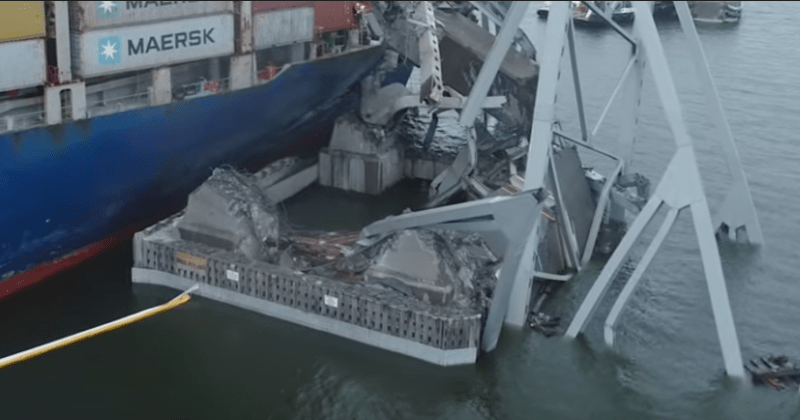
From the recent NYSB footage it appears the demolished pier's marine works, that is the pile caps and the vertical and raking piles underneath the water (or the cassion structure if used), remains intact. The fender system seems complete and there is no visible movement in the pile caps. Only the twin A-frame columns were removed on impact. All four reinforced concrete columns were broken off cleanly. Three of pile caps are now visible with separation face at about 45 degree. Only one column is visible now lodged with the bow of the cargo ship. It is trapped by the falling deck. It is also possible that the deck may be covering some of the remaining three columns which appear to be hollow in section [see post by ZR Shipwright (Marine/Ocean) at 26 Mar 24 15:12] or the photo re-posted below. The RC design code ACI-318 has in recent years has tightened the requirement of stirrups or lateral links, like every alternate vertical bar in compression bar has to be confined by a link, which are glaringly missing in the failed column.
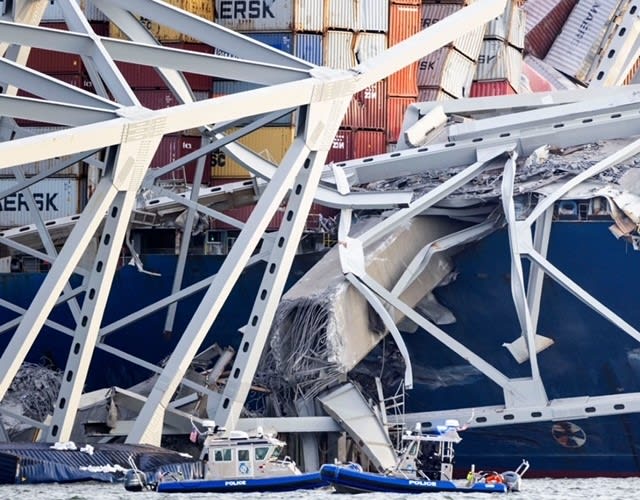
The enhanced video provided by NTSB also shows two locations where materials and dust were blowing away like explosion during impact. This could occur if the RC columns were heavily loaded in compression and failed by buckling.
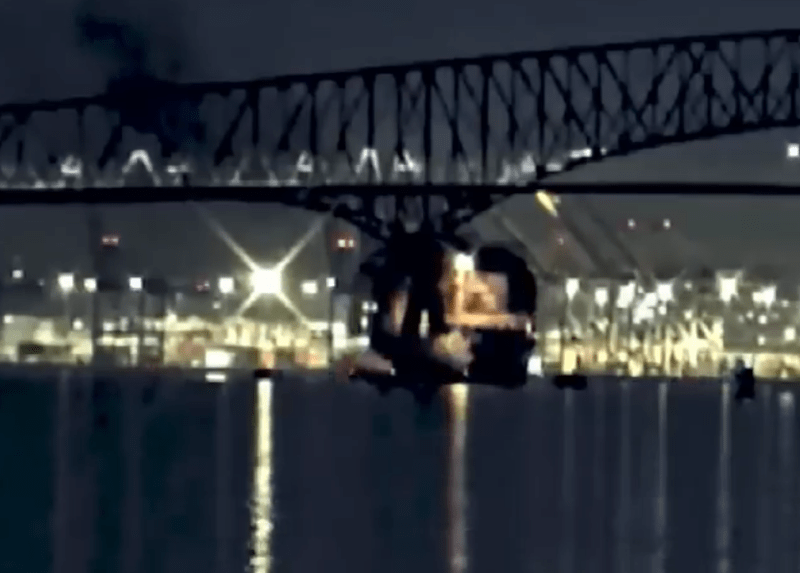
- Status
- Not open for further replies.
Similar threads
- Replies
- 0
- Views
- 575
- Replies
- 13
- Views
- 13K
- Question
- Replies
- 39
- Views
- 21K
- Replies
- 17
- Views
- 11K
- Replies
- 25
- Views
- 25K

![[pipe] [pipe] [pipe]](/data/assets/smilies/pipe.gif)